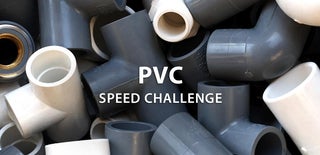Introduction: PVC Pipe Lamp
This pvc pipe lamp was a lot of fun to make and could be done in any number of styles depending on how you drill your holes.
Supplies
2 ft. of PVC
tape measure
2 cardboard tubes
tape
yard stick
drill press (or hand drill)
fine point Sharpie
sander/sandpaper
small round file
plywood
pendant lamp kit
laser cutter (optional)
quick dry tacky glue
cardstock
masking tape
Step 1: Trough
Take two cardboard tubes and tape them together making sure the tape on the top is pressed down into the crease.
Your pvc pipe should sit nicely on top.
Step 2: Vertical Lines
Use a measuring tape to make a mark every half inch around the pvc pipe with a fine point Sharpie.
Hold a yard stick next to the pvc pipe on top of the cardboard tubes.
Tape it in place.
Use the yard stick to draw a line down down the length of the pipe.
Rotate and repeat for each half inch mark.
Step 3: Horizontal Lines
Use a measuring tape to mark every half inch down the length of the pipe.
Place a flat object at the end of the cardboard tubes and tape it in place.
Press the pipe against the flat object at the end of the tubes.
Line your Sharpie up with a mark on the pipe and rotate the pipe to draw a line around the tube.
Repeat for each half inch mark.
Step 4: Cut to Size
2 ft. divided by three is 8 inches. To get three different heights, subtract 3" from one and add it to another.
Measure and cut a 5", 8", and 11" piece.
Step 5: Drill Press Trough
Rig up a trough for your drill press. I happened to have this metal bar that worked out. My cardboard tubes might have worked as well, but they were a bit bulky.
To prevent the tube from popping back at me when drilling, I used two loose zip ties around the bar which was zip tied to the base.
Here's where things get more creative. You can drill your holes in whatever pattern you like using the guidelines to help keep them even. My only tip is to always start with the largest drill bit. If you start small, you end up not having room for the larger bits as you scale up.
After each row, whether vertical, horizontal, or diagonal, change the size of your drill bit.
Step 6: Drill
Step 7: More Drilling
Change up how you drill your holes for each pipe.
Step 8: Sanding
Sand off the red lettering and Sharpie guidelines.
Use a small round file to clean up the inside of the holes where there are bits of pvc still holding on.
Step 9: Base
Assemble the base.
I've attached the cut file for my box for use with a laser cutter. If you don't have a laser cutter, any box will do. You could even use a pre-made box. Just cut holes in the top that are slightly smaller than the pipes and a hole in the back for the lamp kit.
Using quick dry tacky glue, attach the smaller three-hole panel onto the bottom of the larger three-hole panel.
Next glue the front onto the three-hole panel as shown. Use masking tape to secure it.
Attachments
Step 10:
Glue the sides around the corners. You'll need to pull firmly to get these to stretch around. Tape in place.
Step 11:
Glue on the bottom panel. This is the most difficult part of this box. Slip the front in first, then pull firmly onto the sides to get them to lock in place. Use tape to secure it.
Glue the two side pieces on as shown. Again, tape in place.
Step 12:
Put the light bulb inside the box. Then, screw the cap onto the end of the socket as loosely as you can. Fold the two back panels in, sandwiching it between the two parts of the socket.
Hold the back of the box closed while you reach in to hold the cap in place and twist the socket to tighten.
Reach in and screw in the lightbulb.
Once dry, to prevent light leaking out the corners of the box, wrap it in cardstock.
Step 13: Enjoy

Second Prize in the
PVC Speed Challenge














